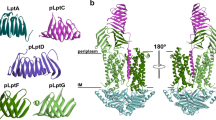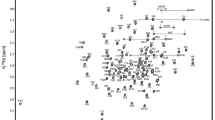Abstract
The cellulosome of Clostridium thermocellum is an elegant and efficient multi-enzyme complex for degrading lignocellulose. The cellulosome contains several dozens of carbohydrate hydrolysis enzymes, which are regulated by the presence of environmental substrates through several pairs of sigma and anti-sigma factors. The anti-sigma factors sense the presence of substrates and transduce the signals into the cell. The sigma factors are then released from the corresponding anti-sigma factors, and they recruit RNA polymerase to transcribe specific cellulosomal genes. However, it is not clear how the extracellular signals are transduced into the cell by the anti-sigma factors. The anti-sigma factors of C. thermocellum contain an N-terminal intracellular domain, a trans-membrane helix, a periplasmic domain, a proline-rich region which is probably required for crossing the cell wall, and a C-terminal carbohydrate-binding domain or glycoside hydrolase domain. The periplasmic domain may play a key role in signal transduction; however, its three-dimensional structure is still unknown. Here we report the NMR resonance assignments of the periplasmic domain of anti-sigma factor RsgI2 from C. thermocellum as a basis for further structural determination and functional studies.


Similar content being viewed by others
References
Delaglio F, Grzesiek S, Vuister GW, Zhu G, Pfeifer J, Bax A (1995) NMRPipe—a multidimensional spectral processing system based on unix pipes. J Biomol NMR 6(3):277–293. doi:10.1007/bf00197809
Fontes C, Gilbert HJ (2010) Cellulosomes: highly efficient nanomachines designed to designed to deconstruct plant cell wall complex carbohydrates. Annu Rev Biochem 79:655–681. doi:10.1146/annurev-biochem-091208-085603
Johnson BA, Blevins RA (1994) NMRView—a computer-program for the visualization and analysis of NMR data. J Biomol NMR 4(5):603–614. doi:10.1007/bf00404272
Kahel-Raifer H, Jindou S, Bahari L, Nataf Y, Shoham Y, Bayer EA, Borovok I, Lamed R (2010) The unique set of putative membrane-associated anti-sigma factors in Clostridium thermocellum suggests a novel extracellular carbohydrate-sensing mechanism involved in gene regulation. FEMS Microbiol Lett 308(1):84–93. doi:10.1111/j.1574-6968.2010.01997.x
Markley JL, Bax A, Arata Y, Hilbers CW, Kaptein R, Sykes BD, Wright PE, Wuthrich K (1998) Recommendations for the presentation of NMR structures of proteins and nucleic acids—(IUPAC Recommendations 1998). Pure Appl Chem 70(1):117–142. doi:10.1351/pac199870010117
Mascher T (2013) Signaling diversity and evolution of extracytoplasmic function (ECF) sigma factors. Curr Opin Microbiol 16(2):148–155. doi:10.1016/j.mib.2013.02.001
Nataf Y, Bahari L, Kahel-Raifer H, Borovok I, Lamed R, Bayer EA, Sonenshein AL, Shoham Y (2010) Clostridium thermocellum cellulosomal genes are regulated by extracytoplasmic polysaccharides via alternative sigma factors. Proc Natl Acad Sci USA 107(43):18646–18651. doi:10.1073/pnas.1012175107
Paget MSB, Helmann JD (2003) Protein family review—the sigma(70) family of sigma factors. Genome Biol 4(1):6. doi:10.1186/gb-2003-4-1-203
Shen Y, Bax A (2013) Protein backbone and sidechain torsion angles predicted from NMR chemical shifts using artificial neural networks. J Biomol NMR 56(3):227–241. doi:10.1007/s10858-013-9741-y
Yaniv O, Fichman G, Borovok I, Shoham Y, Bayer EA, Lamed R, Shimon LJW, Frolow F (2014) Fine-structural variance of family 3 carbohydrate-binding modules as extracellular biomass-sensing components of Clostridium thermocellum anti-sigma(I) factors. Acta Crystallogr D 70:522–534. doi:10.1107/S139900471302926x
Acknowledgments
We thank Professor Sarah Perrett (Institute of Biophysics, Chinese Academy of Sciences) for critically reading the manuscript. This work was supported by the National Basic Research Program of China (973 Program, Grant No. 2011CB707404), the National Natural Science Foundation of China (Grant Nos. 31270784, 31470210, 31171201, and 31070072), and Program for New Century Excellent Talents in University (Grant No. NCET-0900717).
Conflict of interest
The authors declare that they have no conflict of interest.
Author information
Authors and Affiliations
Corresponding authors
Rights and permissions
About this article
Cite this article
Ding, X., Chen, C., Cui, Q. et al. Resonance assignments of the periplasmic domain of a cellulose-sensing trans-membrane anti-sigma factor from Clostridium thermocellum . Biomol NMR Assign 9, 321–324 (2015). https://doi.org/10.1007/s12104-015-9601-7
Received:
Accepted:
Published:
Issue Date:
DOI: https://doi.org/10.1007/s12104-015-9601-7




